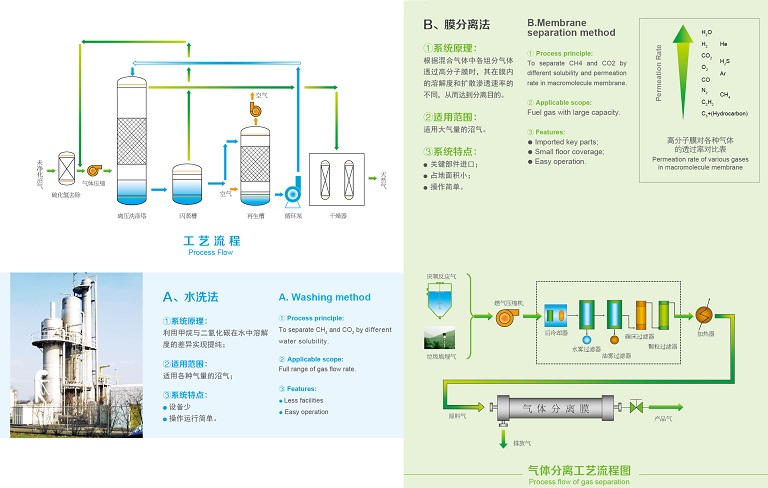沼氣發酵是由多種產甲烷細菌和非產甲烷細菌混合共同發酵完成的。沼氣發酵的階段由厭氧和兼性厭氧的水解性細菌或發酵性細菌將纖維素、淀粉等水解成單糖,并進一步形成丙酮;將蛋白質水解成氨基酸,并進一步形成有機酸的氨;將脂類水解為甘油和脂肪酸,進一步形成丙酸、乙酸、丁酸、乙醇等。第二階段由產氫產乙酸細菌群利用階段產生的有機酸,氧化分解成乙酸和分子氫;第三階段由嚴格厭氧的產甲烷細菌群(methangens)完成。沼氣提純公司提示大家,在這個龐雜的混合發酵體系中,非產甲烷細菌為產甲烷細菌提供生長和產甲烷所需的基質,創造適宜的氧化還原條件,并清除有毒物質;產甲烷細菌為非產甲烷細菌的生化反應解除反饋抑制,創造熱力學上的有利條件;并且兩類菌共同維持環境中適宜的pH值。產甲烷細菌和非產甲烷細菌間通過互營聯合實現甲烷的高效形成。
Biogas fermentation is accomplished by the co-fermentation of various methanogenic and non-methanogenic bacteria. In the first stage of biogas fermentation, cellulose and starch are hydrolyzed into monosaccharides by anaerobic and facultative anaerobic hydrolytic bacteria or fermentative bacteria, and acetone is further formed; protein is hydrolyzed into amino acids and ammonia of organic acids is further formed; lipids are hydrolyzed into glycerol and fatty acids, and propionic acid, acetic acid, butyric acid, ethanol and so on are further formed. In the second stage, the bacteria producing hydrogen and acetic acid utilize the organic acid produced in the first stage to oxidize and decompose into acetic acid and molecular hydrogen. In the third stage, the bacteria producing methangens are strictly anaerobic. The biogas purification company reminds us that in this complex mixed fermentation system, non-methanogenic bacteria provide the matrix for methanogenic bacteria to grow and produce methane, create appropriate redox conditions and remove toxic substances; methanogenic bacteria release feedback inhibition for the biochemical reaction of non-methanogenic bacteria, create thermodynamic favorable conditions; and the two types of bacteria maintain together. The suitable pH value in the environment. Methane-producing bacteria and non-methanogenic bacteria can form methane efficiently through mutual cooperation.
整個厭氧消化過程是一個產甲烷細菌和非產甲烷細菌相互作用,相互制約的動態平衡過程。用于厭氧消化的原料幾乎都是不溶性有機大分子的碳水化合物、脂肪和蛋白質等,只有通過水解酶把它們分解成較小的分子后才能被產氫產乙酸菌和產甲烷細菌利用,終產生甲烷。
The whole anaerobic digestion process is a dynamic equilibrium process in which methanogenic bacteria and non-methanogenic bacteria interact and restrict each other. The raw materials used for anaerobic digestion are almost all insoluble organic macromolecules such as carbohydrates, fats and proteins, which can be utilized by hydrogen-producing Acetobacteria and methanogenic bacteria only after they are decomposed into smaller molecules by hydrolytic enzymes, and finally methane is produced.

水解過程通常較緩慢,因此是含高分子有機物或懸浮物廢液厭氧降解的限速階段。影響水解速度與水解程度的因素很多。胞外酶能否有效接觸到底物是影響水解速率的關鍵。因此大顆粒比小顆粒底物降解要緩慢得多。許多微生物可以產生胞外酶,其中主要的水解酶有脂肪酶、蛋白酶和纖維素酶等。它們的作用是將復雜的大分子水解為可被微生物同化的單體。在有機聚合物占多數的廢物厭氧生物處理中,水解作用是整個過程的限速步驟。
The hydrolysis process is usually slow, so it is the limited stage of anaerobic degradation of wastewater containing macromolecule organic matter or suspended matter. There are many factors affecting the hydrolysis rate and degree. Whether extracellular enzymes can effectively contact the substrate is the key to affect the hydrolysis rate. Therefore, the degradation of large particles is much slower than that of small particles. Many microorganisms can produce extracellular enzymes, including lipase, protease and cellulase. Their function is to hydrolyze complex macromolecules into monomers that can be assimilated by microorganisms. Hydrolysis is a speed-limiting step in the anaerobic biological treatment of wastes with organic polymers as the majority.
近10年來的研究發現,產氫產乙酸菌包括互營單胞菌屬、互營桿菌屬、梭菌屬、暗桿菌屬等。這類細菌能把各種揮發性脂肪酸降解為乙酸和H2。利用乙酸的產甲烷細菌有索氏甲烷絲菌和巴氏甲烷八疊球菌,兩者的生長速率差別較大。在一般的厭氧反應器中,約70%的甲烷由乙酸分解而來,30%由氫氣還原二氧化碳而來。在厭氧反應器中,甲烷產量的70%是由乙酸歧化菌產生的。在反應中,乙酸中的羧基從乙酸分子中分離,甲基終轉化為甲烷,羧基轉化為二氧化碳。
In the past 10 years, it has been found that hydrogen-producing acetic acid bacteria include Mutual Bacillus, Mutual Bacillus, Clostridium, Acinetobacter and so on. These bacteria can degrade various volatile fatty acids into acetic acid and H2. Methanogenic bacteria utilizing acetic acid are Methanothrix soxhlii and Methanococcus Pasteuri, and their growth rates are quite different. In general anaerobic reactors, about 70% of methane is decomposed from acetic acid and 30% from hydrogen to carbon dioxide. In an anaerobic reactor, 70% of methane production is produced by disproportionate acetic acid bacteria. In the reaction, the carboxyl group in acetic acid is separated from the acetic acid molecule, methyl is eventually converted to methane, and carboxyl is converted to carbon dioxide.
This article comes from: biogas purification! I hope that our explanation will be helpful to all of you! More content welcome click: http://m.chinaktws.com, we will provide a satisfactory answer to your questions, welcome your call!
